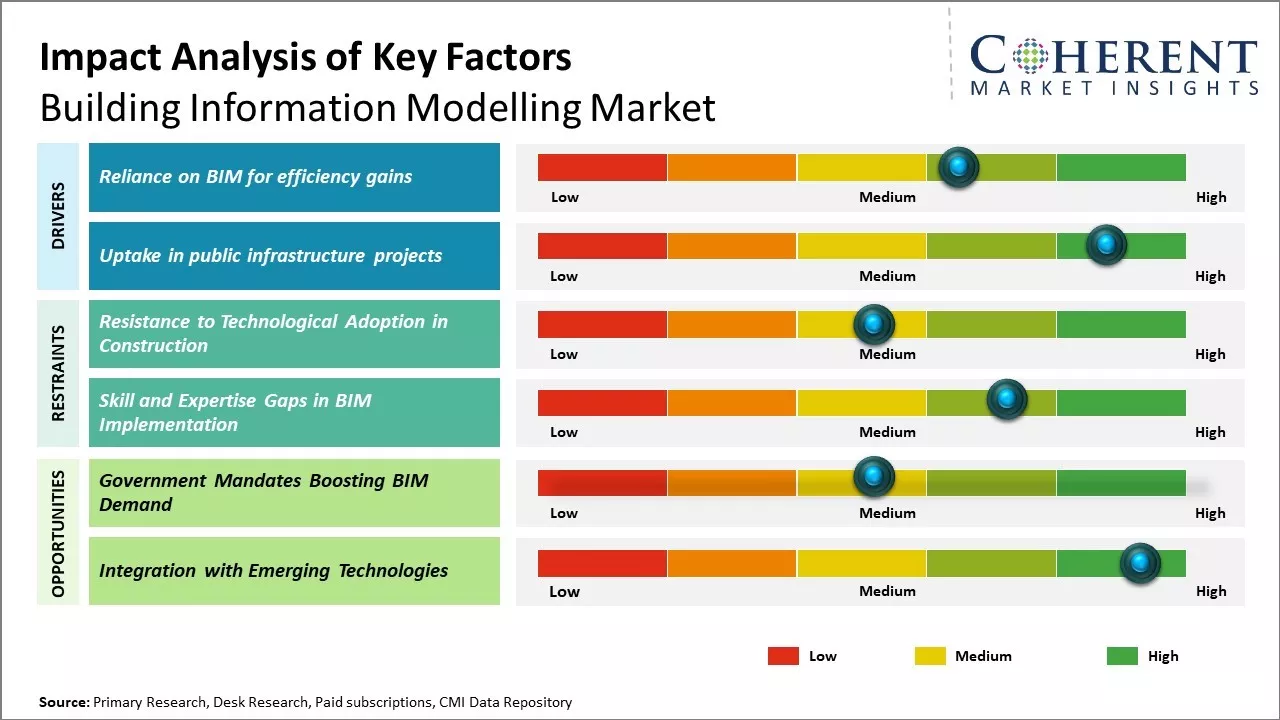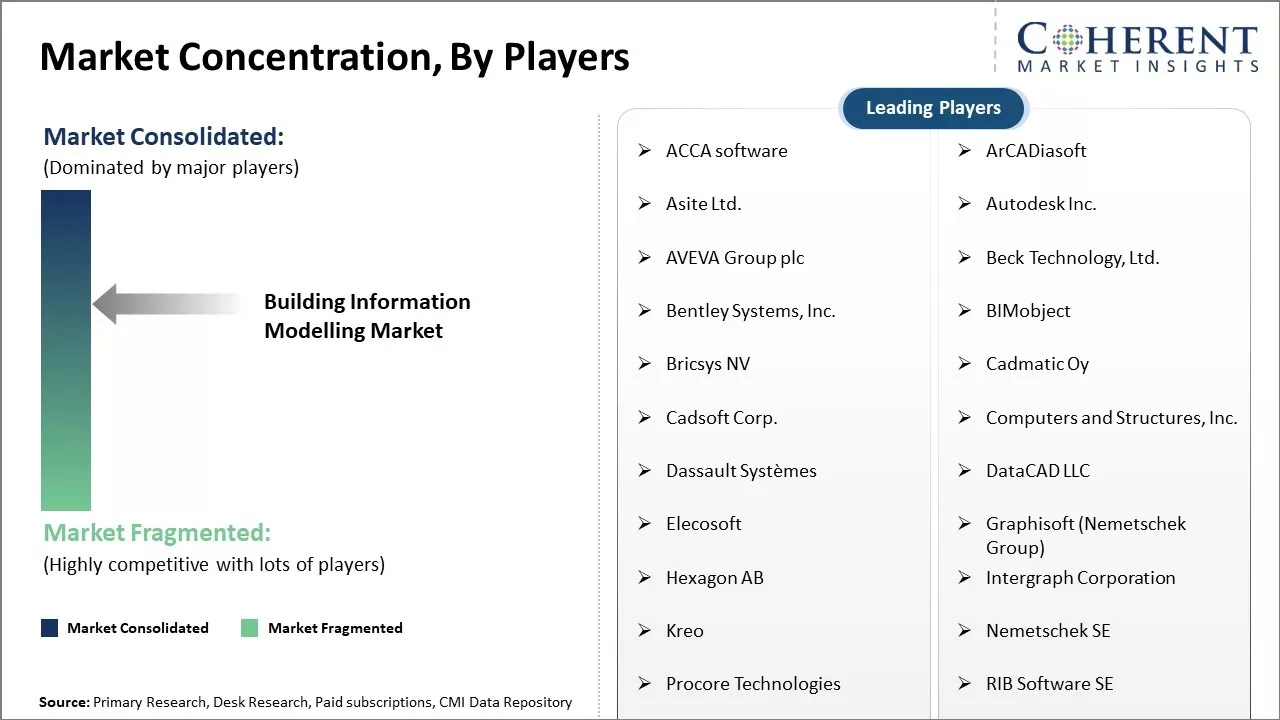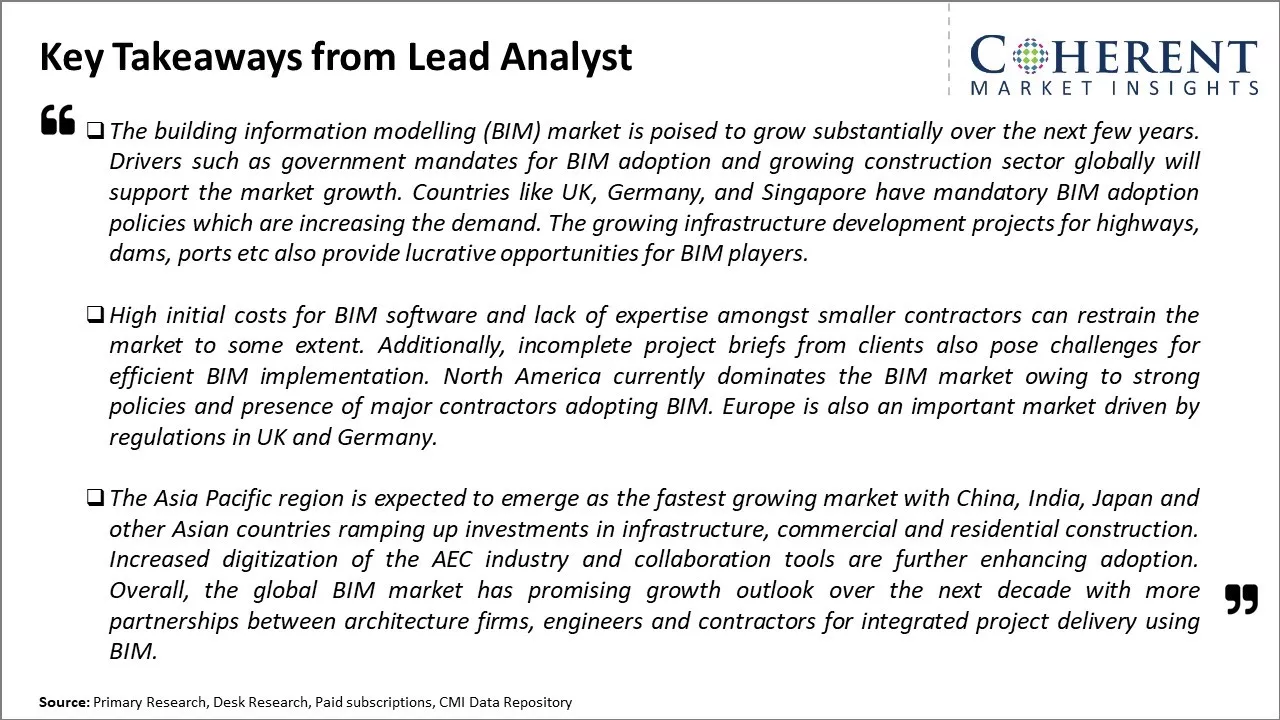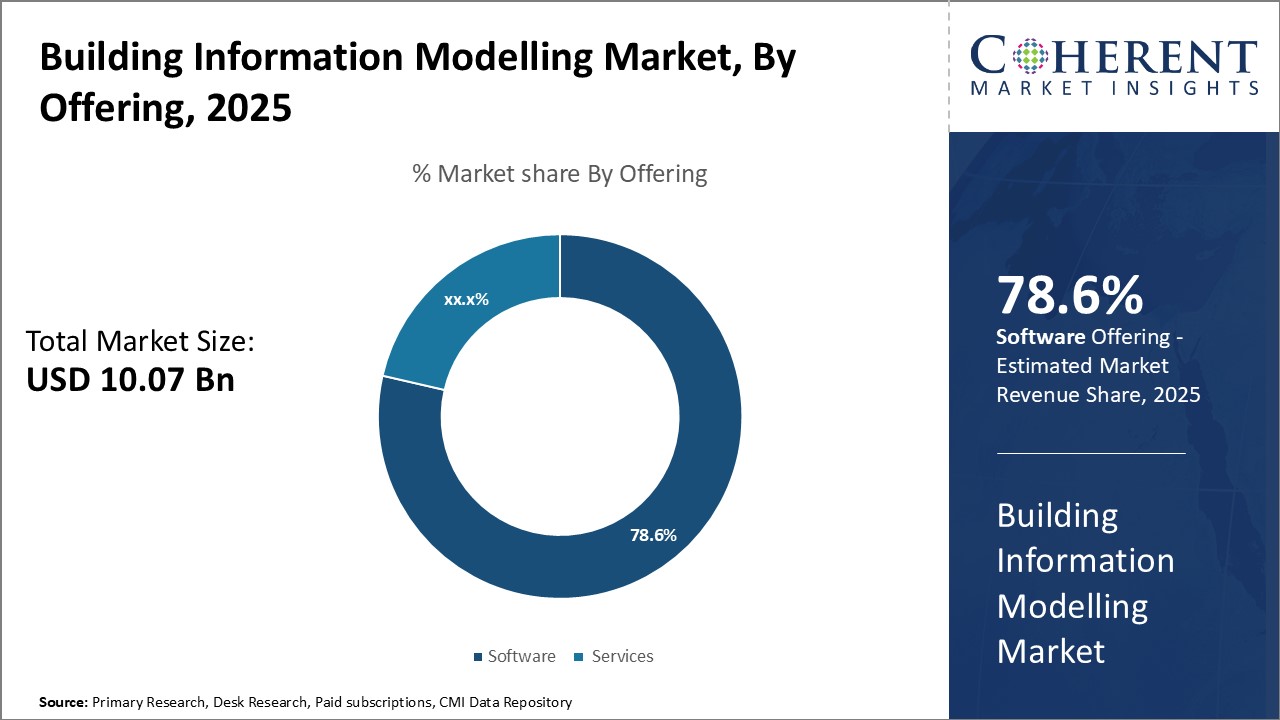Global building information modelling (BIM) market is estimated to be valued at USD 10.07 Bn in 2025 and is expected to reach USD 25.06 Bn by 2032, exhibiting a compound annual growth rate (CAGR) of 13.9% from 2025 to 2032.

Discover market dynamics shaping the industry: Request sample copy
Global building information modelling (BIM) market is expected to witness robust growth over the forecast period. There is an increasing adoption of BIM across various infrastructure and real estate projects globally to enhance design, construction, and operation of buildings. BIM helps in facilitating collaboration and data exchange between the project stakeholders. Furthermore, rising need to reduce project time and costs boosts demand for BIM. Government initiatives promoting the use of BIM in public infrastructure projects is further expected to propel the market growth during the forecast period. However, high initial costs for implementation and lack of standardization may hinder the building information modelling (BIM) market growth.
Reliance on BIM for efficiency gains
Architecture, Engineering and Construction (AEC) industry has traditionally been criticized for its linear and fragmented nature, which leads to inefficiencies in collaboration and coordination across project phases. Building projects involve complex designs involving many stakeholders like architects, engineers, contractors among others. Effective collaboration and coordination between these parties is crucial but has historically been a challenge due to different toolsets, work practices and organizational silos. BIM addresses this issue head-on by providing a common data environment in which a digital representation of the building can be designed, constructed and operated. All team members collaborate on one shared digital model, allowing them to see designs in 3D, catch issues early, work together from different locations, and maintain consistent data throughout the project. This allows for more streamlined workflows and easier tracking of changes, leading to significant productivity and efficiency gains. Contractors can prefabricate building components more accurately based on the BIM model. Issues get resolved during design stage itself rather than construction, avoiding costly delays and change orders. Operations and maintenance teams also benefit as the entire lifecycle data gets captured in BIM. With its compelling value proposition of enhancing collaboration, coordination and optimization of building design and construction processes, reliance on BIM for efficiency gains is a major driver for market growth.
For instance, in March 2023, Autodesk Inc. is an American multinational software corporation acquired UNIFI Labs, Inc., a U.S.-based cloud software solution for organizing, accessing, and managing content in digital design tools like Revit and Civil 3D. The acquisition enhances Autodesk's BIM content accessibility through UNIFI's digital asset management capabilities.

Get actionable strategies to beat competition: Request sample copy
Uptake in public infrastructure projectsGovernment bodies globally are increasingly mandating the use of BIM on public construction projects as it allows for better cost and scheduling oversight. Large infrastructure projects involving multiple contractors and sub-contractors spread over long timelines need high levels of coordination which BIM effectively addresses. Developed countries like U.K., Finland, Norway, South Korea and Singapore have mandated full BIM adoption on public projects. The U.S. government is also actively promoting BIM Level 3 collaboration through its Federal BIM initiative. For infrastructure owners, BIM ensures assets get delivered on-time and on-budget by optimizing design review processes, construction planning, 4D scheduling, cost estimation and facility management handover. This offers significant returns especially for civic projects involving taxpayers’ money. The mandate for BIM by public clients is a key driver propelling the market as infrastructure continues to be a major investment area globally. Contractors are learning to adapt their workflows to comply with these mandates to remain competitive in public sector projects.
For instance, in September 2022, Autodesk unveiled new capabilities across Autodesk Construction Cloud Reality, simplifying the use and value maximization of BIM for construction project teams. The improvements streamline workflows and provide stakeholders instant access to essential model data and information from the office to the field.

To learn more about this report, Request sample copy
Market Challenges: Resistance to Technological Adoption in ConstructionGlobal building information modelling (BIM) market faces several challenges. Contractors and builders have been slow to adopt new technologies and change entrenched workflows. Many firms also lack the technical expertise and skills to implement BIM systems and processes effectively. High upfront costs, interoperability issues between software platforms, and unclear ROI expectations have inhibited greater adoption rates. Developing internationally compatible BIM standards remains an ongoing process, which introduces uncertainties.
Market Opportunities: Government Mandates Boosting BIM Demand
Government mandates in different countries now require BIM usage for public projects, which will drive greater overall demand. Integrating BIM with emerging technologies like AI, VR and IoT allows for new construction and facility management applications. Adoption will likely grow as BIM capabilities improve and software becomes more user-friendly and affordable. Young designers and engineers already highly skilled in digital tools will also propel the industry forward.

Discover high revenue pocket segments and roadmap to it: Request sample copy
Insights, By Offering- Growing adoption of BIM advancements drive software segment growthIn terms of offering, software segment is estimated to contribute the highest share of 78.6% in 2025, owing to growing need for advanced construction modelling and augmented collaboration among project stakeholders. An increasing number of architecture, engineering and construction companies are leveraging BIM software solutions to design structures, streamline documentation processes and facilitate cooperation between project teams spread across locations. Major factors propelling the software segment growth include emerging technologies such as cloud-based platforms, artificial intelligence/machine learning integrations, virtual/augmented reality capabilities and mobile/web apps. These new features enable real-time project updates, remote monitoring, automated clash detection and easy access to models, which boost efficiency. Favourable government initiatives supporting BIM adoption and open standards also boosts demand for interoperable software suites. Most contractors, architects and developers currently utilize 3D/4D/5D modelling software for building designs, cost estimation, simulation, facilities management and virtual prototyping. This widespread software deployment cements their dominant position in the BIM market.
Insights, By Application - Application scope expansion drives commercial segment leadership
In terms of application, commercial segment is estimated to contribute the highest share of 47.88% in 2025, owing to the growing recognition of BIM's benefits across various commercial project types. BIM solutions see vast usage in large complex infrastructure like offices, airports, hospitals, and others for collaborative design coordination, prefabrication planning, clash detection and construction sequencing. These are increasingly adopted for MEP (mechanical, electrical, plumbing), structural and energy modelling of commercial facilities to reduce construction errors and enhance quality. Moreover, BIM enables developers to visualize projects remotely during pandemic, obtain approvals digitally and reduce costs through modular construction. Growing commercial real estate sector and construction of green buildings also stimulates demand. Governments leverage BIM for public infrastructure models while owners use it for facilities/asset management of property portfolios. This wide scope across commercial construction, asset management and smart building functions cements its leadership over other application areas.
Insights, By End Users- Technological expertise drives architects segment dominance
In terms of end users, architects segment is expected to contribute the highest share of 41.95% in 2025, owing to their expertise in leveraging cutting-edge BIM technologies. As an integral part of project conceptualization and design stages, architects are at the forefront of 3D/4D modelling and visualizing building components in BIM. These people maximize software potentials for spatial coordination, sustainable design, energy analysis and automated documentation. Additionally, a majority of architects pursue ongoing training and certifications in advanced BIM technologies to seamlessly integrate models with Engineers and Contractors. This enhances collaboration during construction documentation, site coordination and facilities management. Moreover, architect-designed projects also often entail complex MEP, structural and specialty designs requiring expert BIM utilization. Their ability to streamline design workflows using virtual/augmented reality and mobile apps is further driving demand. Architects also assume leadership roles in implementing BIM standards and protocols on project sites. Therefore, digital design capabilities, technological proficiency and collaborative expertise cement architect dominance as prime BIM end users.

Need a Different Region or Segment? Customize now
North America has established itself as the dominating region in the global building information modelling (BIM) market and is expected to contribute the highest share of 43.4% in 2025. This can be attributed to the strong presence of leading BIM solution providers and early adoption of BIM practices across major end-use industries such as construction, architecture and engineering in the region. Countries like the U.S. and Canada have seen widespread implementation of BIM over the last decade, driven by efforts to streamline documentation, improve collaboration and reduce project cycle times. Several regulatory mandates introduced in the U.S. particularly have boosted demand and usage of BIM solutions. Furthermore, the region is also a hub for technological innovation which has consistently generated new BIM-enabled applications and platforms.
The Asia Pacific region has emerged as the fastest growing market for building information modelling globally and is expected to contribute the highest CAGR of 18.42% in 2025. Rapid urbanization and infrastructure development initiatives across developing nations have opened up significant opportunities for BIM solution providers. Countries like China, India, Singapore and Australia are seeing rising infrastructure expenditure, which is prompting construction companies and owners to adopt advanced digital technologies for planning, designing and managing building lifecycles. This has contributed to the burgeoning demand for BIM and attracted many global players to expand their presence. Importantly, governments in the region have also started recognizing the potential of BIM for achieving quality, efficiency and sustainability targets in the construction sector. For instance, regulations in China now require BIM usage on major state-funded projects.
Building Information Modelling Market Report Coverage
| Report Coverage | Details | ||
|---|---|---|---|
| Base Year: | 2024 | Market Size in 2025: | USD 10.07 Bn |
| Historical Data for: | 2020 To 2024 | Forecast Period: | 2025 To 2032 |
| Forecast Period 2025 to 2032 CAGR: | 13.9% | 2032 Value Projection: | USD 25.06 Bn |
| Geographies covered: |
|
||
| Segments covered: |
|
||
| Companies covered: |
ACCA software, ArCADiasoft, Asite Ltd., Autodesk Inc., AVEVA Group plc, Beck Technology, Ltd., Bentley Systems, Inc., BIMobject, Bricsys NV, Cadmatic Oy, Cadsoft Corp., Computers and Structures, Inc., Dassault Systèmes, DataCAD LLC, Elecosoft, Graphisoft (Nemetschek Group), Hexagon AB, Intergraph Corporation, Kreo, Nemetschek SE, Procore Technologies, RIB Software SE, Robert Mcneel &Associates, Trimble Solutions Corporation, Vizerra SA |
||
| Growth Drivers: |
|
||
| Restraints & Challenges: |
|
||
Uncover macros and micros vetted on 75+ parameters: Get instant access to report
*Definition: " Building Information Modelling (BIM) Market consists of software solutions that are used in architecture, engineering and construction projects to facilitate collaboration and management of building data during design, construction and operation phases. BIM allows stakeholders to visualize and simulate activities required to construct a building or infrastructure digitally before it is built physically, thereby reducing errors and saving costs."
Share
Share
About Author
Suraj Bhanudas Jagtap is a seasoned Senior Management Consultant with over 7 years of experience. He has served Fortune 500 companies and startups, helping clients with cross broader expansion and market entry access strategies. He has played significant role in offering strategic viewpoints and actionable insights for various client’s projects including demand analysis, and competitive analysis, identifying right channel partner among others.
Missing comfort of reading report in your local language? Find your preferred language :
Transform your Strategy with Exclusive Trending Reports :
Frequently Asked Questions
Joining thousands of companies around the world committed to making the Excellent Business Solutions.
View All Our Clients
US Reciprocal Tax Impact Analysis On Building Information Modelling Market
Stay updated on tariff changes with expert insights and timely information